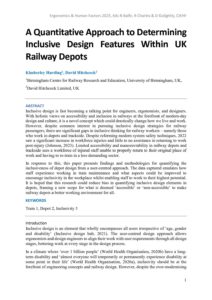| Document | Author Kimberley Harding & David Hitchcock |
| Abstract Inclusive design is fast becoming a talking point for engineers, ergonomists, and designers. With holistic views on accessibility and inclusion in railways at the forefront of modern-day design and culture, it is a novel concept which could drastically change how we live and work. However, despite common interest in pursuing inclusive design strategies for railway passengers, there are significant gaps in inclusive thinking for railway workers – namely those who work in depots and trackside. Despite reforming modern system safety techniques, 2022 saw a significant increase in workforce injuries and little to no assistance in returning to work post-injury (Johnson, 2023). Limited accessibility and manoeuvrability in railway depots and trackside sees a workforce of injured staff unable to properly return to their original place of work and having to re-train in a less demanding sector. In response to this, this paper presents findings and methodologies for quantifying the inclusiveness of depot design from a user-centred approach. The data captured emulates how staff experience working in train maintenance and what aspects could be improved to encourage inclusivity in the workplace whilst enabling staff to work to their highest potential. It is hoped that this research could reduce bias in quantifying inclusive design elements in depots, framing a new scope for what is deemed ‘accessible’ or ‘non-accessible’ to make railway depots a better working environment for all. |

